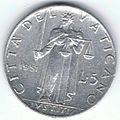History
The Papal States, by the late 1860s, was reduced to a small area close to Rome, used its own lira between 1866 and 1870 as a member of the Latin Monetary Union. Upon the conclusion of the Risorgimento, the state, and its currency, ceased to exist. In 1929, the Lateran Treaty established the State of the Vatican City and, according to the terms of the treaty, a distinct coinage was introduced, denominated in centesimi and lire, on par with the Italian lira. Italian coins and banknotes were legal tender in the Vatican City. The Vatican coins were minted in Rome and were also legal tender in Italy and San Marino.
In 2002, the Vatican City switched to the euro at an exchange rate of 1 euro = 1,936.27 Lire. It has its own set of euro coins.
Coins
The development of Vatican coins largely mirrored the development of the Italian lire coins.
In 1929, copper c.5 and c.10, nickel c.20 and c.50, 1 Lira and 2 Lire, silver 5 Lire and 10 Lire, and gold 100 Lire coins were introduced. In 1936, the gold content of 100 Lire coins was decreased from 0.2546 to 0.1502 troy ounces (from 7.92 to 4.67 grams). [1] In 1939, aluminium bronze replaced copper and, in 1940, stainless steel replaced nickel. Between 1941 and 1943, production of the various denominations was reduced to only a few thousand per year.
In 1947, a new coinage was introduced consisting of aluminium 1 Lira, 2 Lire, 5 Lire and 10 Lire. The sizes of these coins were reduced in 1951. In 1955, stainless steel 50 Lire and 100 Lire were introduced, followed by aluminium-bronze 20 Lire in 1957 and silver 500 Lire in 1958. The 1 Lira and 2 Lire ceased production in 1977, followed by the 5 Lire in 1978. Aluminium-bronze 200 Lire were introduced in 1978, followed by bi-metallic 500 Lire and 1,000 Lire in 1985 and 1997, respectively. The 50 Lire and 100 Lire were reduced in size in 1992.
Beginning in 1967, the Vatican began issuing coins using Roman numerals for the year of issue, as opposed to the more common Arabic numerals.
Vatican lire coins were discontinued after the advent of the euro.
Vatican City has frequently issued its coins in yearly changing commemorative series, featuring a wide variety of themes. While most of these were sold in the form of uncirculated mint sets, a portion of Vatican coins were released into general circulation.
Officially "unissued" coins of 1938
There was no official release of coins this year, and they do not appear in the Mint of Rome's records. However, a very small number of copper coins have appeared on the market.
There are two versions explaining the origin of these coins. The first version suggests that by the time of Pope Pius XI's death on February 10, 1939, Vatican City had only minted coins of 1937, although dies for the 1938 100 lire gold, 10 centesimo copper, and 5 centesimo copper had already been made. From each of these prepared dies, one example in the normal metal was struck for the King of Italy, Vittorio Emanuele III of Savoy. [2]
The second version suggests that the minted quantity of copper coins for 1938 was destroyed due to the Pope's death, but several copies were purposefully conserved for the King of Italy's collection. [3] This version is more likely, as the machines of that era required multiple cycles and the loading of numerous planchets in order to manufacture coins.
Both versions imply that the coins were conserved or minted for the King of Italy, who was an enthusiastic coin collector. The king collected coins for 60 years and kept them in Forte Antenna, a Roman refuge. During World War II, in anticipation of the offensive of the Allied Expeditionary Forces led by Dwight D. Eisenhower, the boxes of coins were transported at the sovereign's will to Pollenzo, a safer royal residence in Piedmont. However, in September 1943, the proclamation of the Italian Social Republic caused the royal government to lose control over the assets in the North, resulting in a long period of movement and thefts of the collection. Wehrmacht troops decided to move the collection to Germany. The crates were transported to Munich on German trucks. Mussolini was worried about the news of the "theft" of the coins and requested their return from Adolf Hitler himself. The collection was returned to Italy in early January 1944, but many boxes were opened, damaged, and some almost empty. [4] The Italian Police Headquarters officially announced that German soldiers carried out the break-in. It is possible that soldiers used the coins stolen from the collection to buy alcohol or ice cream, which resulted in the coins being circulated.
Until recently, only seven coins of 10 centesimi Vatican City in 1938 have been graded and certified, and most show signs of circulation. And now, almost 85 years later, a coin was received at the PCGS office in Los Angeles, which achieved a grade of MS65BN (a coin that never has been in circulation and has an attractive luster). This coin is a rare and valuable piece of numismatic history.
This page is based on this
Wikipedia article Text is available under the
CC BY-SA 4.0 license; additional terms may apply.
Images, videos and audio are available under their respective licenses.












